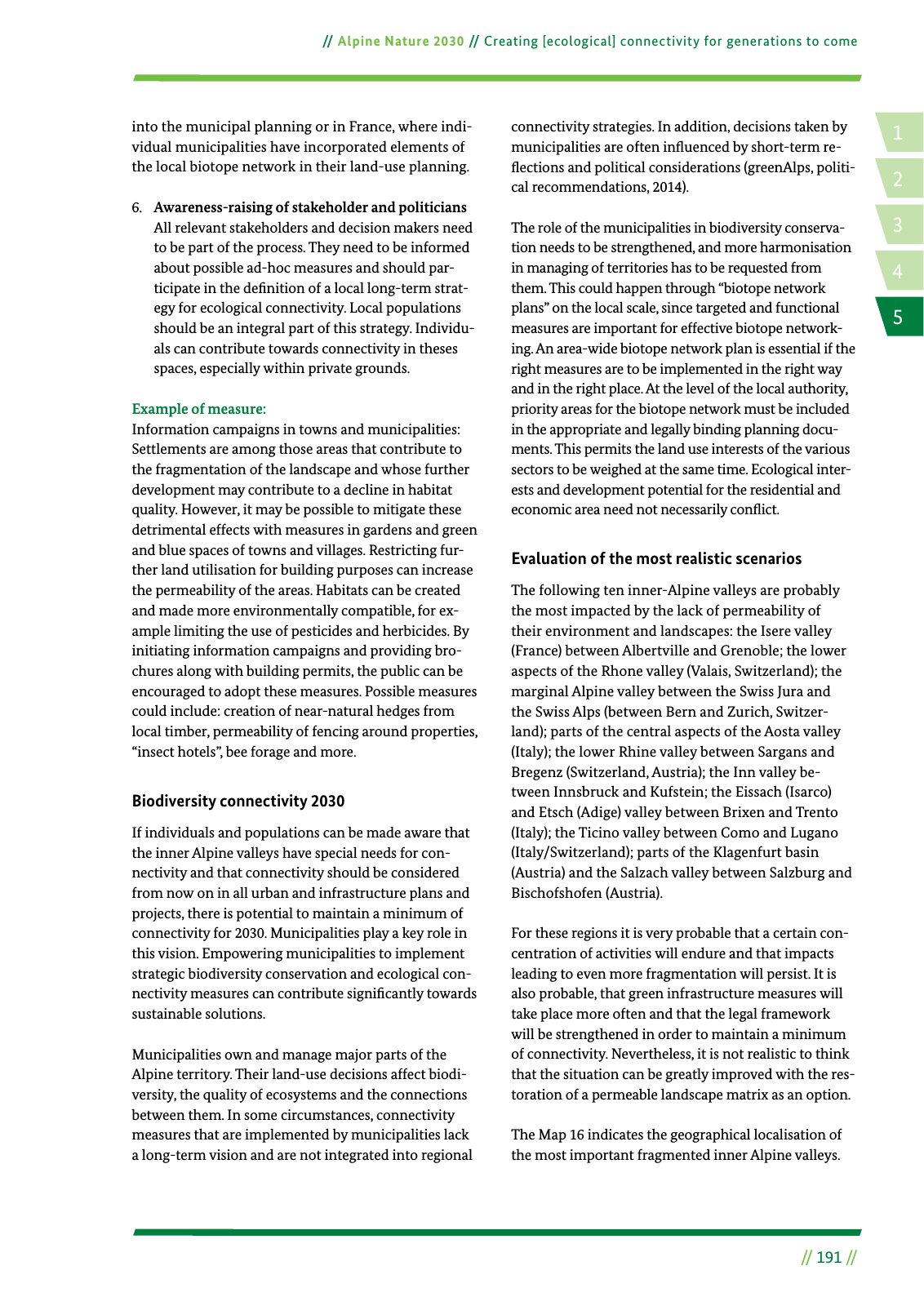14 2 5 3 Alpine Nature 2030 Creating ecological connectivity for generations to come 191 connectivity strategies In addition decisions taken by municipalities are often in uenced by short term re ections and political considerations greenAlps politi cal recommendations 2014 The role of the municipalities in biodiversity conserva tion needs to be strengthened and more harmonisation in managing of territories has to be requested from them This could happen through biotope network plans on the local scale since targeted and functional measures are important for effective biotope network ing An area wide biotope network plan is essential if the right measures are to be implemented in the right way and in the right place At the level of the local authority priority areas for the biotope network must be included in the appropriate and legally binding planning docu ments This permits the land use interests of the various sectors to be weighed at the same time Ecological inter ests and development potential for the residential and economic area need not necessarily con ict Evaluation of the most realistic scenarios The following ten inner Alpine valleys are probably the most impacted by the lack of permeability of their environment and landscapes the Isere valley France between Albertville and Grenoble the lower aspects of the Rhone valley Valais Switzerland the marginal Alpine valley between the Swiss Jura and the Swiss Alps between Bern and Zurich Switzer land parts of the central aspects of the Aosta valley Italy the lower Rhine valley between Sargans and Bregenz Switzerland Austria the Inn valley be tween Innsbruck and Kufstein the Eissach Isarco and Etsch Adige valley between Brixen and Trento Italy the Ticino valley between Como and Lugano Italy Switzerland parts of the Klagenfurt basin Austria and the Salzach valley between Salzburg and Bischofshofen Austria For these regions it is very probable that a certain con centration of activities will endure and that impacts leading to even more fragmentation will persist It is also probable that green infrastructure measures will take place more often and that the legal framework will be strengthened in order to maintain a minimum of connectivity Nevertheless it is not realistic to think that the situation can be greatly improved with the res toration of a permeable landscape matrix as an option The Map 16 indicates the geographical localisation of the most important fragmented inner Alpine valleys Biodiversity connectivity 2030 If individuals and populations can be made aware that the inner Alpine valleys have special needs for con nectivity and that connectivity should be considered from now on in all urban and infrastructure plans and projects there is potential to maintain a minimum of connectivity for 2030 Municipalities play a key role in this vision Empowering municipalities to implement strategic biodiversity conservation and ecological con nectivity measures can contribute signi cantly towards sustainable solutions Municipalities own and manage major parts of the Alpine territory Their land use decisions affect biodi versity the quality of ecosystems and the connections between them In some circumstances connectivity measures that are implemented by municipalities lack a long term vision and are not integrated into regional into the municipal planning or in France where indi vidual municipalities have incorporated elements of the local biotope network in their land use planning 6 Awareness raising of stakeholder and politicians All relevant stakeholders and decision makers need to be part of the process They need to be informed about possible ad hoc measures and should par ticipate in the de nition of a local long term strat egy for ecological connectivity Local populations should be an integral part of this strategy Individu als can contribute towards connectivity in theses spaces especially within private grounds Example of measure Information campaigns in towns and municipalities Settlements are among those areas that contribute to the fragmentation of the landscape and whose further development may contribute to a decline in habitat quality However it may be possible to mitigate these detrimental effects with measures in gardens and green and blue spaces of towns and villages Restricting fur ther land utilisation for building purposes can increase the permeability of the areas Habitats can be created and made more environmentally compatible for ex ample limiting the use of pesticides and herbicides By initiating information campaigns and providing bro chures along with building permits the public can be encouraged to adopt these measures Possible measures could include creation of near natural hedges from local timber permeability of fencing around properties insect hotels bee forage and more

Hinweis: Dies ist eine maschinenlesbare No-Flash Ansicht.
Klicken Sie hier um zur Online-Version zu gelangen.
Klicken Sie hier um zur Online-Version zu gelangen.